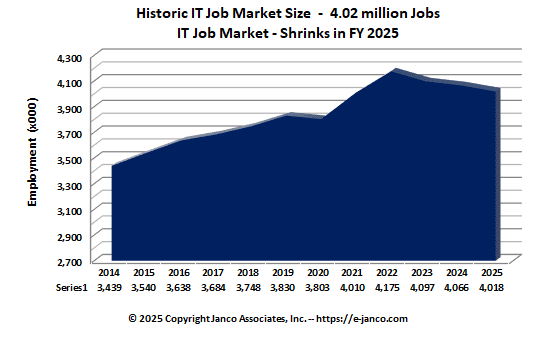Job losses continue unabated
The number of jobs eliminated continues at a rate that is beyond any recession in the last 60 years...
For the current employment recession, employment peaked in December 2007, and this recession is by far the worst recession since WWII in percentage terms, and 2nd worst in terms of the unemployment rate (only early '80s recession with a peak of 10.8 percent was worse).
As the budget season begins, many enterprises are continuing to look at a slow job recovery with limited hiring and continued pressure to cut costs. One solution that may CIOs to staff shortages is to hire IT professionals on a part time basis.
Temporary and part-time work might be becoming more common. The Bureau of Labor Statistics put the number of Americans too discouraged to continue looking for work and part-time workers who want but cannot find full-time work at 17.1 percent, up from 16.1 percent a year ago. The professional and business services sector added 28,000 jobs, mostly temporary hires. Jobs in the leisure and hospitality category, which obviously employs lots of part-time folks, grew by 34,000.
The graph below shows the job losses from the start of the employment recession, in percentage terms (as opposed to the number of jobs lost).
The dotted line is ex-Census hiring. The two lines have joined since the decennial Census is almost over.
Historic IT Job Market Size
Updated with current data
For current data go IT Job Market Size to see the historic job market growth trend detail data
Subscribe to our Newsletter to get this information delivered to your inbox as soon as it is released. SUBSCRIBE

The Bureau of Labor Statistics calculated a seasonally adjusted net loss of 95,000 jobs for September based on its Establishment Survey. The private sector added a modest 64,000 jobs, but 77,000 layoffs at the Census and another 76,000 in state and local government kept the overall numbers in negative territory for the fourth month in a row. Discounting the Census layoffs, the economy lost 18,000 jobs. The change in total nonfarm payroll employment for August was revised from minus 54,000 to minus 57,000, and the change for July was revised from minus 54,000 to minus 66,000.
Based on its Household Survey, the BLS put the official unemployment rate, U3, at 9.6 percent, unchanged since August. An alternative measure, U6, which includes Americans too discouraged to continue looking for work and part-time workers who want but cannot find full-time work, surged to 17.1 percent. A year ago, that figure was 16.1 percent.
This puts the official number of unemployed Americans at 14.8 million. In September 2009, that figure was 15.1 million. Unemployed, underemployed and workers so in despair they've given up looking clock in at somewhere around 16 million. The employment-population ratio stayed at 58.5 percent and the civilian labor force participation rate stayed at 64.7 percent.
This marks the 17th month that the official unemployment rate has been above 9 percent. Another two months above that level will mark the longest stretch of joblessness above 9 percent since the Great Depression.
Read on...




